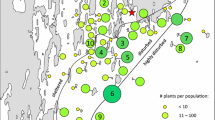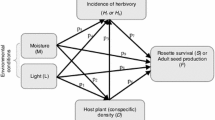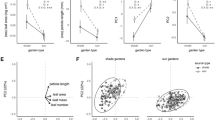Abstract
Plant tolerance to herbivory may depend on local environmental conditions. Models predict both increased and decreased tolerance with increasing resources. Transgenerational effects of herbivory may result in cross-generation tolerance. We evaluated within- and potential between-generation consequences of deer browsing in light-gap and understory habitats in the forest-edge herb, Campanulastrum americanum. Plants were assigned to deer-browsed, simulated-herbivory, and control (undamaged) treatments in the two light environments. In light gaps, plants were eaten earlier, more frequently, and had less vegetative recovery relative to uneaten plants than in the understory. As a result, browsed light-gap plants had a greater reduction in flowers and fruit than understory plants. This reduced tolerance was in part because deer browsing damaged plants in light gaps more than those in the understory. However, in the simulated herbivory treatment, where damage levels were similar between light habitats, plants growing in high-resource light gaps also had reduced tolerance of herbivory relative to those in the forest understory. C. americanum’s reproductive phenology was delayed by reduced light and the loss of the apical meristem. As a result, deer-browsed plants in the light gap flowered slightly later than uneaten plants in the understory. C. americanum has a polymorphic life history and maternal flowering time influences the frequency of annual and biennial offspring. The later flowering of deer-browsed plants in light gaps will likely result in a reduced frequency of high-fitness annual offspring and an increase in lower fitness biennial offspring. Therefore, additional between-generation costs of herbivory are expected relative to those predicted by fruit number alone.




Similar content being viewed by others
References
Agrawal AA (2001) Transgenerational consequences of plant responses to herbivory: an adaptive maternal effect? Am Nat 157:555–569
Agrawal AA, Laforsch C, Tollrian R (1999) Transgenerational induction of defences in animals and plants. Nature 401:60–63
Augustine DJ, Frelich LE (1998) Effects of white-tailed deer on populations of understory forb in fragmented deciduous forests. Conserv Biol 12:995–1004
Baskin JM, Baskin CC (1984) The ecological life cycle of Campanula americana in northcentral Kentucky. Bull Torrey Bot Club 111:329–337
Bergelson J, Crawley MJ (1992) The effects of grazers on the performance of individuals and populations of scarlet-gilia, Ipomopsis aggregata. Oecologia 90:435–444
Blundell AG, Peart DR (2001) Growth strategies of a shade tolerant tropical tree: the interactive effects of canopy gaps and simulated herbivory. J Ecol 89:608–615
Bullock J, Hill CB, Silvertown J (1994) Demography of Cirsium vulgare in a grazing experiment. J Ecol 82:101–111
Cote SD, Rooney TP, Tremblay JP, Dussault C, Waller DM (2004) Ecological impacts of deer overpopulation. Annu Rev Ecol Evol Syst 35:113–147
Crawley MJ (1989) Insect herbivores and plant population dynamics. Annu Rev Entomol 34:531–564
Crawley MJ, Nachapong M (1985) The establishment of seedlings from primary and regrowth seeds of ragwort (Senecio jacobaea). J Ecol 73:255–262
Freeman RS, Brody AK, Neefus CD (2003) Flowering phenology and compensation for herbivory in Ipomopsis aggregata. Oecologia 136:394–401
Galloway LF (2002) The effect of maternal phenology on offspring characters in the herbaceous plant Campanula americana. J Ecol 90:851–858
Galloway LF (2005) Maternal effects provide phenotypic adaptation to location environmental conditions. New Phytol 166:93–100
Galloway LF, Burgess KS (2009) Manipulation of flowering time: phenological integration and maternal effects. Ecology 90:2139–2148
Galloway LF, Etterson JR (2007) Transgenerational plasticity is adaptive in the wild. Science 318:1134–1136
Galloway LF, Etterson JR (2009) Plasticity to canopy shade in a monocarpic herb: within and between generation effects. New Phytol 182:1003–1012
Galloway JN, Aber JD, Erisman JW, Seitzinger SP, Howarth RW, Cowling EB, Cosby BJ (2003) The nitrogen cascade. BioScience 53(4):341-356
Häsler H, Senn J, Edwards P (2008) Light-dependent growth responses of young Abies alba to simulated ungulate browsing. Funct Ecol 22:48–57
Hawkes CV, Sullivan JJ (2001) The impact of herbivory on plants in different resource conditions: a meta-analysis. Ecology 82:2045–2058
Hilbert DW, Swift DM, Detling JK, Dyer MI (1981) Relative growth rates and the grazing optimization hypothesis. Oecologia 51:14–18
Holeski LM (2007) Within and between generation phenotypic plasticity in trichome density of Mimulus guttatus. J Evol Biol 20:2092–2100
Huhta AP, Rautio P, Hellstrom K, Saari M, Tuomi J (2009) Tolerance of a perennial herb, Pimpinella saxifraga, to simulated flower herbivory and grazing: immediate repair of injury or postponed reproduction? Plant Ecol 201:599–609
Husheer SW, Roberston AW, Coomes DA, Frampton CM (2006) Herbivory and plant competition reduce mountain beech seedling growth and establishment in New Zealand. Plant Ecol 183:245–256
Irwin DL, Aarssen LW (1996) Effects of nutrient level on cost and benefit of apical dominance in Epilobium ciliatum. Am Midl Nat 136:14–28
Kilkenny FF, Galloway LF (2008) Reproductive success in varying light environments: direct and indirect effects of light on plants and pollinators. Oecologia 155:247–255
Knight TM (2004) The effects of herbivory and pollen limitation on a declining population of Trillium grandiflorum. Ecol Appl 14:915–928
Lammerink J, MacGibbon DB, Wallace AR (1984) Effect of the cabbage aphid (Brevicoryne brassicae) on total glucosinolate in the seed of oilseed rape (Brassica napus). N Z J Agric Res 27:89–92
Lennartsson T, Tuomi J, Nilsson P (1997) Evidence for an evolutionary history of overcompensation in the grassland biennial Gentianella campestris (Gentianaceae). Am Nat 149:1147–1155
Lennartsson T, Nilsson P, Tuomi J (1998) Induction of overcompensation in the field gentian, Gentianella campestris. Ecology 79:1061–1072
Lesage L, Crête M, Huot J, Ouellet JP (2002) Use of forest maps versus field surveys to measure summer habitat selection and sexual segregation in northern white-tailed deer. Can J Zool 80:717–726
Maschinski J, Whitham TG (1989) The continuum of plant responses to herbivory: the influence of plant association, nutrient availability, and timing. Am Nat 134:1–19
McGraw JB, Furedi MA (2005) Deer browsing and population viability of a forest understory plant. Science 307:920–922
McNaughton SJ (1983) Compensatory plant growth as a response to herbivory. Oikos 40:329–336
McShea WJ, Underwood HB, Rappole JH (1997) The science of overabundance: deer ecology and population management. Smithsonian Institution Press, Washington
Milbrath LR (2008) Growth and reproduction of invasive Vincetoxicum rossicum and V. nigrum under artificial defoliation and different light environments. Botany 86:1279–1290
Mueller RC, Wade BD, Gehring CA, Whitham TG (2005) Chronic herbivory negatively impacts cone and seed production, seed quality and seedling growth of susceptible pinyon pines. Oecologia 143:558–565
Muth NZ, Kluger EC, Levy JH, Edwards MJ, Niesenbaum RA (2008) Increased per capita herbivory in the shade: necessity, feedback, or luxury consumption? Ecoscience 15:182–188
Norghauer JM, Malcolm JR, Zimmerman BL (2008) Canopy cover mediates interactions between a specialist caterpillar and seedlings of a Neotropical tree. J Ecol 96:103–113
Nuismer SL, Cunningham BM (2005) Selection for phenotypic divergence between diploid and autotetraploid Heuchera grossulariifolia. Evolution 59:1928–1935
Paige KN, Whitham TG (1987) Overcompensation in response to mammalian herbivory: the advantage of being eaten. Am Nat 129:407–416
Pilson D, Decker KL (2002) Compensation for herbivory in wild sunflower: response to simulated damage by the head-clipping weevil. Ecology 83:3097–3107
Rautio P, Huhta AP, Piippo S, Tuomi J, Juenger T, Saari M, Aspi J (2005) Overcompensation and adaptive plasticity of apical dominance in Erysimum strictum (Brassicacae) in response to simulated browsing and resource availability. Oikos 111:179–191
Rooney TP, Waller DM (2003) Direct and indirect effects of white-tailed deer in forest ecosystems. For Ecol Manage 181:165–176
Russell FL, Zippin SB, Fowler NL (2001) Effects of white-tailed deer (Odocoileus virginianus) on plants, plant populations and communities: a review. Am Midl Nat 146:1–26
SAS Institute (2005) SAS/STAT version 9.1.3. SAS Institute, Cary
Steets JA, Ashman TL (2004) Herbivory alters the expression of a mixed-mating system. Am J Bot 91:1046–1051
Steets JA, Knight TM, Ashman TL (2007) The interactive effects of herbivory and mixed mating for the population dynamics of Impatiens capensis. Am Nat 170:113–127
Thiemann JA, Webster CR, Jenkins MA, Hurley PM, Rock JH, White PS (2009) Herbaceous-layer impoverishment in a post-agricultural southern Appalachian landscape. Am Midl Nat 162:148–168
Tiffin P (2000) Mechanisms of tolerance to herbivore damage: what do we know? Evol Ecol 14:523–536
Tufto J, Andersen R, Linnell J (1996) Habitat use and ecological correlates of home range size in a small cervid: the roe deer. J Anim Ecol 65:715–724
Virginia Department of Game and Inland Fisheries (2007) Virginia deer management plan 2006–2015. Wildlife information publication. Virginia Department of Game and Inland Fisheries, Richmond
Wallace LL, McNaughton SJ, Coughenour MB (1985) Effects of clipping and four levels of nitrogen on the gas exchange, growth and production of two East African graminiods. Am J Bot 72:222–230
Whigham DF (1990) The effect of experimental defoliation on the growth and reproduction of a woodland orchid, Tipularia discolor. Can J Bot 68:1812–1816
Wise MJ, Abrahamson WG (2005) Beyond the compensatory continuum: environmental resource levels and plant tolerance of herbivory. Oikos 109:417–428
Wise MJ, Abrahamson WG (2007) Effects of resource availability on tolerance of herbivory: a review and assessment of three opposing models. Am Nat 169:443–454
Wise MJ, Abrahamson WG (2008) Applying the limiting resource model to plant tolerance of apical meristem damage. Am Nat 172:635–647
Yang LH (2008) Pulses of dead periodical cicadas increase herbivory of American bellflowers. Ecology 89:1497–1502
Acknowledgments
We thank Mountain Lake Biological Station (University of Virginia) for logistical support, L. Dierkes and C. Jenkins for field assistance, two anonymous reviewers for comments on an earlier version of the manuscript, and NSF REU-Sites grant DBI-0453380 to M. L. B. S. and DEB-0316298 to L. F. G. for financial support. The experiment complied with the current laws and the authors have no conflict of interest.
Author information
Authors and Affiliations
Corresponding author
Additional information
Communicated by Judith Bronstein.
Rights and permissions
About this article
Cite this article
Lin, S.M., Galloway, L.F. Environmental context determines within- and potential between-generation consequences of herbivory. Oecologia 163, 911–920 (2010). https://doi.org/10.1007/s00442-010-1634-0
Received:
Accepted:
Published:
Issue Date:
DOI: https://doi.org/10.1007/s00442-010-1634-0




